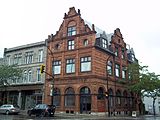
Annesley Hall is the all-female residence at Victoria College, University of Toronto. The residence is located across from the Royal Ontario Museum and is designated a National Historic Site of Canada.
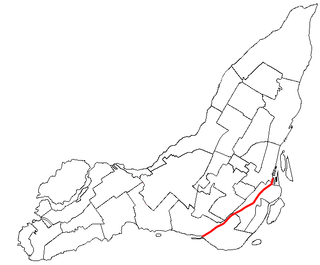
The Lachine Canal is a canal passing through the southwestern part of the Island of Montreal, Quebec, Canada, running 14.5 kilometres from the Old Port of Montreal to Lake Saint-Louis, through the boroughs of Lachine, Lasalle and Sud-Ouest.

Victorian architecture is a series of architectural revival styles in the mid-to-late 19th century. Victorian refers to the reign of Queen Victoria (1837–1901), called the Victorian era, during which period the styles known as Victorian were used in construction. However, many elements of what is typically termed "Victorian" architecture did not become popular until later in Victoria's reign, roughly from 1850 and later. The styles often included interpretations and eclectic revivals of historic styles (see Historicism). The name represents the British and French custom of naming architectural styles for a reigning monarch. Within this naming and classification scheme, it followed Georgian architecture and later Regency architecture, and was succeeded by Edwardian architecture.

Saint Jacques Street, or St. James Street, is a major street in Montreal, Quebec, Canada, running from Old Montreal westward to Lachine.
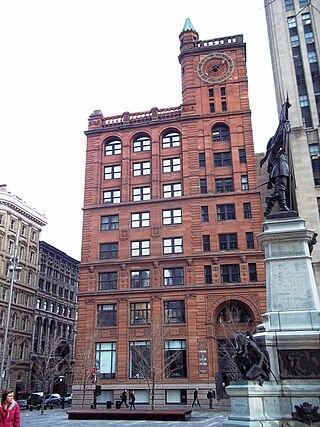
Montreal's New York Life Insurance Building is an office building at Place d'Armes in what is now known as Old Montreal, erected in 1887-1889. At the time of its completion, it was the tallest commercial building in Montreal with the first eight floors were designed for retail office space, that quickly filled with the city's best lawyers and financiers. When the clock tower was completed, the owner filled the ninth and tenth floors with the largest legal library in the entire country as a gift to tenants. The building is next to another historic office tower, Aldred Building.

The Molson Bank Building was built at the corner of St. Peter and St. James streets in Old Montreal as the headquarters of the Molson Bank in 1866 by order of founder William Molson (1793-1875). It was the first building in Montreal to be built in the Second Empire style, designed by George Browne working with his son John James George Browne. It is also known as The Downtown Eastside or the Roosevelt Hotel.

Notre-Dame Street is a historic east-west street located in Montreal, Quebec, Canada. It runs parallel to the Saint Lawrence River, from Lachine to the eastern tip of the island in Pointe-aux-Trembles, then continuing off the island into the Lanaudière region.

Glenville Historic District, also known as Sherwood's Bridge, is a 33.9 acres (13.7 ha) historic district in the Glenville neighborhood of the town of Greenwich, Connecticut. It is the "most comprehensive example of a New England mill village within the Town of Greenwich". It "is also historically significant as one of the town's major staging areas of immigrants, predominantly Irish in the 19th century and Polish in the 20th century" and remains "the primary settlement of Poles in the town". Further, "[t]he district is architecturally significant because it contains two elaborate examples of mill construction, designed in the Romanesque Revival and a transitional Stick-style/Queen Anne; an excellent example of a Georgian Revival school; and notable examples of domestic and commercial architecture, including a Queen Anne mansion and an Italianate store building."

McGill Street is a street in Montreal named after James McGill after whom McGill University is named. The former head office building of Canadian National Railway Company, built for its predecessor Grand Trunk Railway, still stands on McGill Street and is now occupied by Quebec government offices.
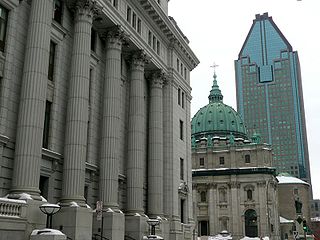
Metcalfe Street is a north–south street located in downtown Montreal, Quebec, Canada. It links Sherbrooke Street in the north and René Lévesque Boulevard in the south. It is best known for being the street on which the Sun Life Building, Mary, Queen of the World Cathedral, and other notable buildings are located. South of René Lévesque Boulevard, the street is known as Cathedral Street. The street borders the eastern side of both Dorchester Square and Place du Canada, to the south.

The Robillard Building once located at 974, boulevard Saint Laurent, was a landmark building in Montreal, Quebec, Canada, situated in Montreal's Chinatown on the corner of rue Viger and boulevard Saint Laurent. On 17 November 2016, the building was destroyed by fire. Despite being a famous landmark, the Robillard Building did not have a heritage status and was not rebuilt. The site remained empty from 2016 until 2022. As of 2022, a condominium is being built on the site.
The architecture of St. John's, Newfoundland and Labrador has a style distinct from that of the rest of Canada, and its major buildings are remnants of its history and prestige as the first British colonial capital. The city of St. John's has had a long history, with inhabitation dating to the 16th century onwards. As the city grew, so, too, did the landscape. Buildings took a variety of styles according to the styles and means available to build the structures. Starting as a fishing outpost for European fishermen, St. John's consisted mostly of the homes of fishermen, sheds, storage shacks, and wharves. Of course, these structures were small and constructed out of wood. Like many other cities of the time, as the Industrial Revolution took hold and new methods and materials for construction were introduced, the landscape changed as the city grew in width and height. The Great Fire of 1892 destroyed most of the downtown core, and most residential and other wood-frame buildings date from this period. Often compared to San Francisco because of its hilly terrain and steep maze of residential streets, housing in St. John's is typically painted in bright colours, unlike most other parts of Canada.

The Northville Historic District is located in Northville, Michigan. It was designated a Michigan State Historic Site in 1970 and listed on the National Register of Historic Places in 1972. The district is roughly bounded by Cady Street, Rogers Street, and Randolph Street; alterations to the boundaries of the city-designated district in 2003 and 2007 included structures on the opposite sides of the original bounding streets within the district. The district is located in the heart of old Northville, and is primarily residential, although the 73 contributing structures, include several commercial buildings and a church. The majority of the district contains Gothic Revival houses constructed between 1860 and 1880.

The Monument-National is a historic Canadian theatre located at 1182 Saint Laurent Boulevard in Montreal, Quebec. With a capacity of over 1,600 seats, the venue was erected between 1891 and 1894 and was originally the cultural centre of the Saint-Jean-Baptiste Society.

The Jonesborough Historic District is a historic district in Jonesborough, Tennessee, that was listed on the National Register of Historic Places as Jonesboro Historic District in 1969.

Central Chambers is a building at the corner of Elgin Street and Queen Street in Ottawa that is a National Historic Site. It is located at 42 to 54 Elgin Street, next to Bell Block. It faces the Canadian War Memorial at Confederation Square. Central Chambers was built between 1890 and 1893 and designed by John James Browne of Montreal, an example of Queen Anne Revival commercial architecture. Formerly serving as an office for the Canadian Atlantic Railway, it now houses the National Capital Commission.
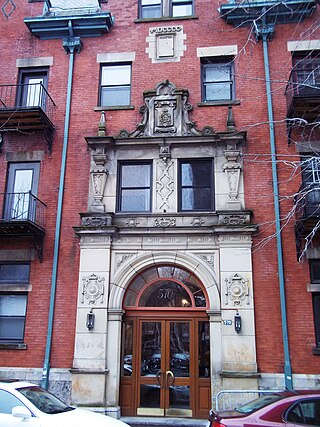
Marlborough Apartments is an apartment building in Montreal, Quebec, Canada. Its address is 570 Milton Street in the Milton Parc neighbourhood. It was designated a National Historic Site of Canada on November 16, 1990.

The Grey Nuns' Hospital was a hospital in Montreal, Quebec, Canada that operated from 1695 to 1880. It is located south of Place d'Youville and west of Rue Saint-Pierre.

Lady Meredith House, also known as the H. Vincent Meredith Residence, is a historic mansion located at 1110 Pine Avenue West on the corner of Peel Street, in what is today known as the Golden Square Mile of Montreal, Quebec. It was originally named Ardvarna and is now owned by McGill University. The building was designated as a National Historic Site of Canada on November 16, 1990. The house is situated at an altitude of 129 m.

Downtown LaPorte Historic District is a national historic district located at LaPorte, LaPorte County, Indiana. The district encompasses 70 contributing buildings in the central business district of LaPorte. It developed between about 1860 and 1930, and includes examples of Queen Anne, Romanesque Revival, and Neoclassical style architecture. Notable buildings include the Zahrt Blocks, Ridgway Hotel (1863), Higday and Collins Blocks (1886–1888), LaPorte County Courthouse (1890–1894), Odd Fellows Building (1895), Lonn's Block (1889), People's Bank (1912), U.S. Post Office (1912), New York Central Depot (1909), Masonic Temple (1910), and Hotel Rumely (1912).

